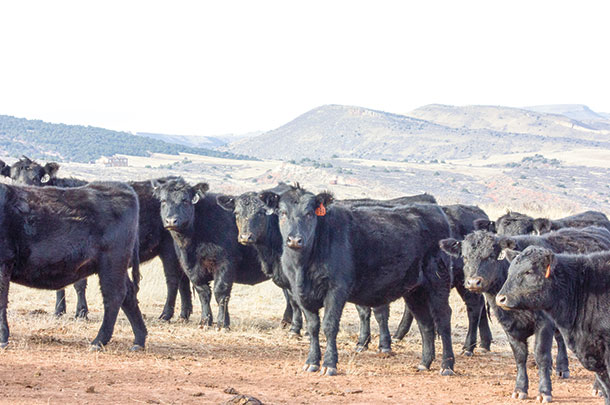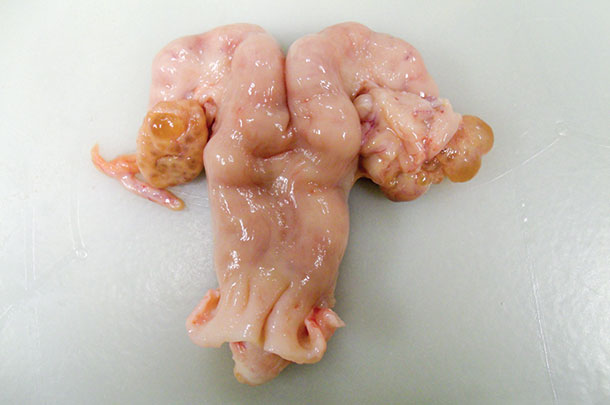Heifers that give birth early in their first calving season remain in the herd longer and wean heavier calves.
Questions remain as to whether there are genes associated with this. Studies have reported genetic markers that associate with age at first calving, which could indicate a genetic component.
On the other hand, the repeatability of giving birth early in subsequent years is low, and intensive selection for heifers that give birth early in the calving season will not result in cows that all give birth in a short period of time. This is because environmental factors like nutritional status and health can have huge impacts on reproductive performance.
Still, it remains clear that you can improve your bottom line by selecting replacement heifers that give birth early, even if it never improves the genetics of the herd as far as fertility is concerned.

One management strategy is to breed as many heifers as possible and retain those that conceive early, but this requires good record-keeping practices.
The percentage of heifers that conceive to first service is typically in the range of 50 to 70 percent. Therefore, to have a group of replacement heifers that all give birth early requires that you maintain a greater number of heifers, at least through pregnancy diagnosis.
Some operations do not have the resources to do this and need ways to try to select heifers that will be more likely to conceive early. One way to do this is to have your veterinarian do a reproductive tract score to evaluate development of the reproductive tract a month or two before the start of the breeding season.
Reproductive tract score
A reproductive tract score (RTS) is performed by rectal palpation of the reproductive tract. Reproductive tract development is scored on a 5-point scale that evaluates the size of the ovaries and the uterus as well as the presence of a large follicle (RTS 4) or corpus luteum (RTS 5) that indicates that a heifer is peri-pubertal or pubertal.
In contrast, a small juvenile reproductive tract would be given an RTS of 1 or 2.
Many veterinarians and producers do not see the value of a reproductive tract score because they believe the same thing can be accomplished simply by selecting the oldest and heaviest heifers as replacement females. Research has demonstrated that reproductive tract score is a better predictor of pregnancy rate and calving day than age, bodyweight or body condition score at breeding.
In addition, heifers with a low reproductive tract score that become pregnant are less likely to conceive as 2-year-olds than heifers with a reproductive tract score of 4 or 5. From this, we can conclude that when done by a skilled veterinarian, a reproductive tract score not only predicts pubertal status, pregnancy rate and calving day but also identifies heifers with a greater potential to produce the three to five calves necessary to recoup their development costs.
Follicle counts
Why would a greater RTS be associated with increased reproductive longevity? Research from our laboratory has focused on the number of microscopic eggs within the ovaries. When the number of these eggs becomes depleted, a mammalian female will reach the end of her reproductive life.
The best way we currently have to estimate the number of microscopic eggs in a heifer’s ovaries is to do an ultrasonographic scan and count the number of antral follicles on the screen because a heifer with more antral follicles will have more microscopic follicles in her ovaries.
Increased numbers of antral follicles are associated with larger ovaries and a larger uterus, which may be the connection between reproductive tract scores, reproductive longevity and number of antral follicles.
A number of studies have demonstrated that increased numbers of antral follicles in heifers and cows are associated with earlier conception dates. Therefore, if a veterinarian is performing reproductive tract scores using an ultrasound machine, the addition of an antral follicle count may increase the predictive value of a tract score and aid in selecting replacement heifers that will give birth early.
There are size limitations to when a rectal palpation can be performed. Therefore, research continues to investigate methods to predict reproductive longevity at a younger age.

Fortunately, reproductive traits that are expressed early in a heifer’s life (antral follicle count, age at puberty, reproductive tract score, uterine size, age at first calving) have greater heritability than those expressed later in life. For example, a number of genetic markers have been identified that associate with follicle number, and these might be aids to select for age at first calving and reproductive longevity. One of these is the muscle gene, Titin, which has been identified as a genetic marker for marbling as well.
Coding for protein
This raises another consideration. We need to consider what selection for production traits does to reproduction in the cow herd. Selection for milk production has resulted in a decrease in fertility in dairy cows, and this can happen in beef cows as well.
Research from the U.S. Meat Animal Research Center indicated that selection for a form of the myostatin gene associated with increased rib-eye area and decreased fat depth resulted in an increase in age at puberty in heifers.
This did not result in a decrease in pregnancy rate or an increase in calving day, but it emphasizes the need to understand how genetic selection for growth and carcass traits can impact fertility in the cow herd and the utility of genetic markers of fertility to maintain fertility while selecting for production traits.
We also need to remember that a gene is more than just a sequence; it is a code for a protein that has biological function, and there are ways to increase or decrease the amount of protein a gene makes. Research on heifer development at the U.S. Meat Animal Research Center identified feeding strategies in the peri-pubertal period that appear to change the numbers of follicles a heifer has.
At the same time, there were increases in the function of a number of genes that control early follicle formation and development, indicating that nutritional programming is changing gene function within the developing ovary to increase follicle numbers.
While all of this may seem to add complexity to selecting replacement heifers, there are really just a few concepts to keep in mind. Selection is a management tool that can be used to improve reproductive performance in the cow herd, even if there is no genetic improvement to fertility. It is important to consider the impact of selection for production traits on reproduction in the cow herd.
Finally, remember that a gene is more than just a marker for selection purposes. It also has biological functions that can be harnessed to improve the performance of our cows.
If we apply these concepts when selecting and developing replacement heifers, reproductive performance will improve. Your veterinarian and extension specialists can help you with your selection and development strategies. ![]()
Robert Cushman is a research physiologist with USDA-ARS U.S. Meat Animal Research Center. Email him at Robert Cushman.
PHOTO 1: Ultrasonography is a technology that can be used to improve reproductive tract evaluations in beef heifers. Photo provided by Robert Cushman.
PHOTO 2: Heifers that give birth early in their first calving season remain in the herd longer and wean heavier calves. Photo provided by staff.
PHOTO 3: A bovine ovary with a large pre-ovulatory follicle and a large number of antral follicles, the small blister-like structures covering the surface of the ovary. This ovary would indicate that the heifer was close to puberty (RTS 4 or 5). Photo provided by Robert Cushman.








